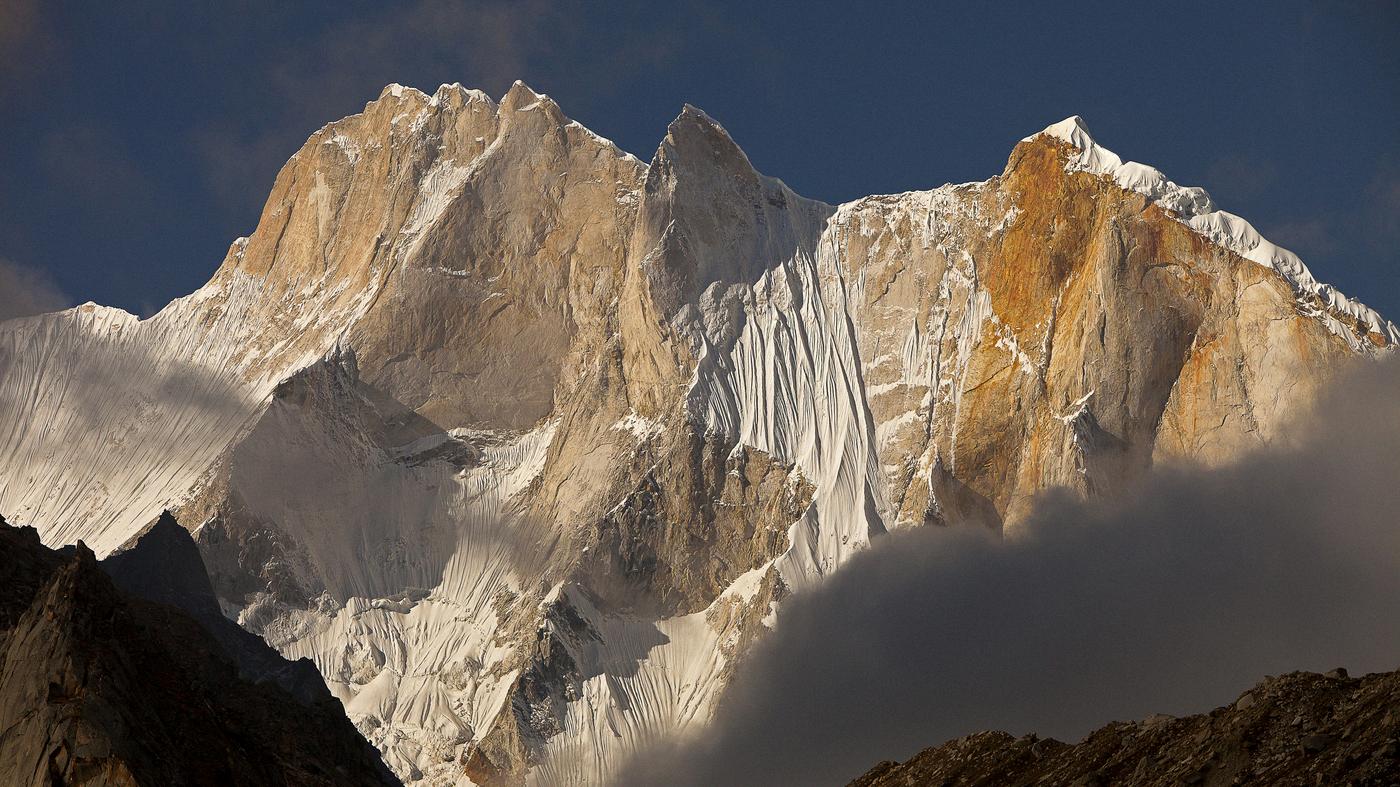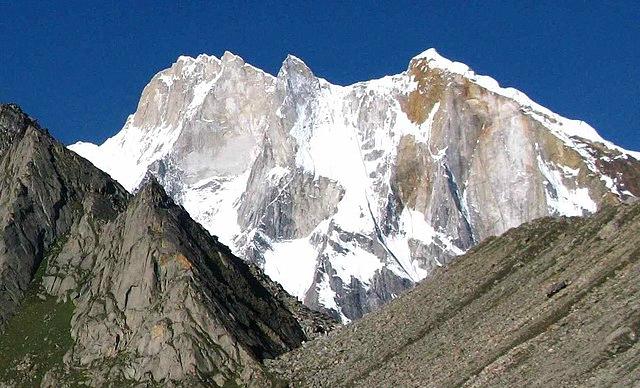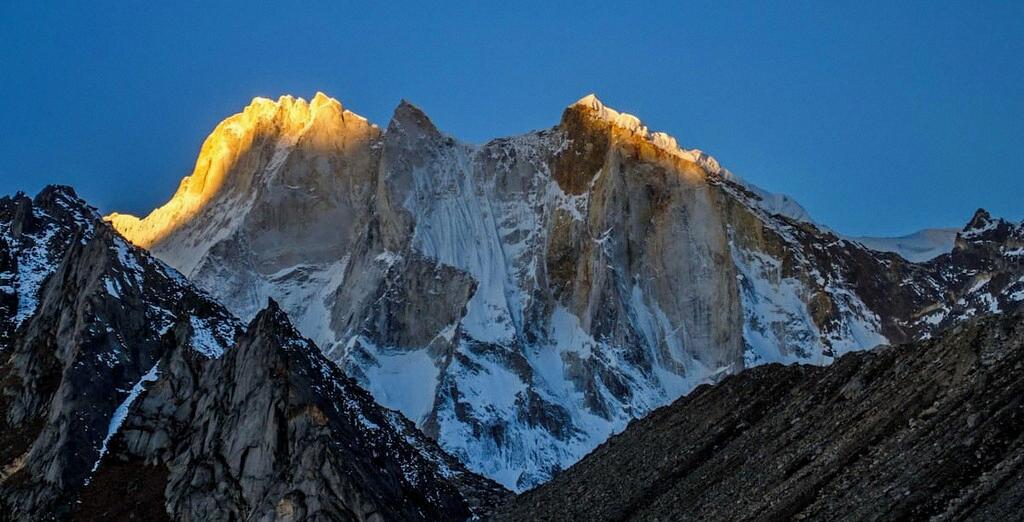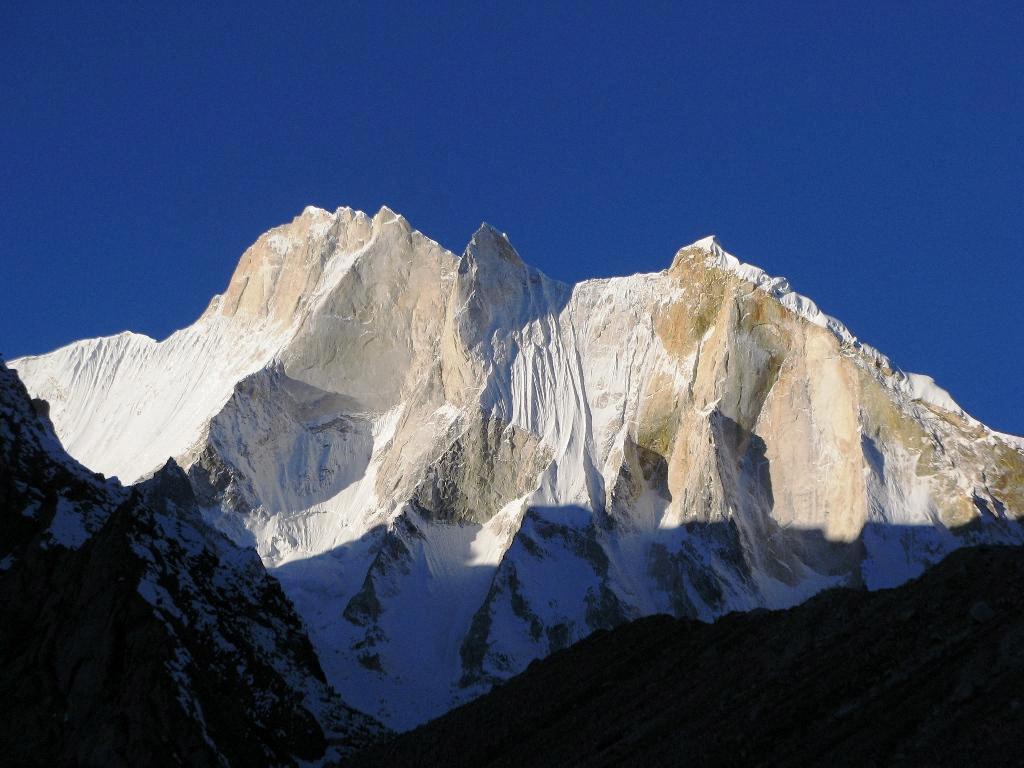Meru Peak, located in the Garhwal Himalayas of India, is a mountain that has been deemed the “anti-Everest.” While over 4,000 people have successfully reached the summit of Mount Everest, Meru Peak remains relatively unknown to the general public. However, this mountain is revered by climbers for its technical difficulties and dangerous terrain.
The central peak of Meru stands at nearly 22,000 feet tall, making it one of the tallest peaks in the Himalayas. Its unique shape resembles a shark’s fin, which has made it a challenge for climbers to conquer. In fact, it took three attempts by a team of alpinists, led by Conrad Anker, Jimmy Chin, and Renan Ozturk, to finally reach the summit via the Shark’s Fin route.
The Shark’s Fin route is considered to be one of the most technically challenging and dangerous routes in the world. It involves scaling a steep, narrow ridge that leads to the summit, with a sheer drop of thousands of feet on either side. The route requires a high level of skill, endurance, and mental strength, as well as the ability to adapt to the extreme weather conditions that can quickly change on the mountain.
Despite the risk and difficulty of the climb, climbers from arund the world continue to be drawn to Meru Peak. The mountain is known for its stunning views of the surrounding Himalayas, including peaks like Shivling and Kedar Dome. It is also home to unique flora and fauna, such as the Himalayan black bear and the snow leopard.
For those interested in climbing Meru Peak, it is important to be properly prepared with the right equipment, physical fitness, and mountaineering experience. It is recommended to climb with a reputable guide or climbing organization to ensure safety and success on the mountain.
Meru Peak is a challenging and awe-inspiring mountain that has been conquered by only a select few. Its technical difficulties and unique shape have made it a coveted destination for climbers around the world. While it may not be as well-known as Mount Everest, Meru Peak remains a true test of skill and endurance for those willing to take on the challenge.
The Climbers Who Have Conquered Meru Peak
Conrad Anker, Jimmy Chin, and Renan Ozturk are the first people to climb the central peak of Mount Meru, which is located in the Gharwal Himalayas. This historic achievement took place in 2011, and it marked a significant milestone in the history of mountaineering. The team overcame numerous challenges and obstacles, including extreme weather conditions, high altitude, and difficult terrain, to reach the summit of the nearly 22,000-foot-tall mountain. Their accomplishment has inspired many climbers to attempt the same feat, and it has cemented their place in the annals of mountaineering history.
Source: npr.org
Number of People Who Have Climbed Meru Peak
According to available data, more than 4,000 people have conquered the summit of Mt. Meru in the Indian Himalayas.
Exploring the Significance of Meru as the ‘Anti-Everest’
Meru Peak is called the ‘anti-Everest’ because it is a mountain that is revered by experienced climbers for its technical difficulties, but remains largely unknown to the general public. While Everest is the tallest mountain in the world and attracts many climbers who seek to conquer its height, Meru Peak is a much smaller mountain located in the Indian Himalayas. However, desite its smaller size, Meru is known for its challenging and technical climbing routes, including the Shark’s Fin route which has only been successfully climbed a handful of times. Unlike Everest, which can be ascended by skilled climbers with the help of guides and fixed ropes, Meru requires a higher level of technical climbing skills, including ice climbing and mixed climbing. Due to its challenging nature, Meru is often considered to be a more pure and authentic climbing experience than Everest. As a result, it has earned the nickname ‘anti-Everest’ as it offers a completely different type of challenge for climbers.
The Successful Climb of Meru
Meru Peak has been successfully climbed by several mountaineers over the years. However, the Shark’s Fin route, which is considered to be the most technically challenging and dangerous, remained unclimbed for many years. In 2008, a team of three mountaineers attempted to climb the Shark’s Fin but had to abandon their mission due to bad weather conditions. However, two years later, the same team returned and successfully achieved the world’s first ascent of the Shark’s Fin route, thereby conquering Meru Peak. Since then, several other mountaineers have successfully climbed the peak using various routes.
Comparing the Difficulty of Climbing Meru and Everest
Meru is considered to be harder than Everest. While Everest is the tallest mountain in the world, Meru is known to be the most difficult to climb due to its unique features, such as the Shark’s Fin, a sheer wall of rock that ascends 20,000 feet. This is a much more challenging obstacle than anyhing on Everest, including the famous Hillary Step. Additionally, no one has yet successfully made the ascent up Meru’s Shark’s Fin, which further emphasizes the difficulty of this climb. while Everest is a significant challenge for climbers, Meru presents a much greater level of difficulty and danger.
Source: en.wikipedia.org
The Fear of Climbing the Most Terrifying Mountain
The Annapurna massif, located in the Himalayas, is widely considered to be the scariest mountain to climb. This is due to the fact that the main peak of the massif, Annapurna I, has a staggeringly high fatality rate of 29%. This means that for every 100 climbers who attempt to summit Annapurna I, 29 will not make it back alive. Since 1900, approximately 244 expeditions have attempted to climb Annapurna I, resulting in a total of 72 deaths. The next most dangerous mountain to climb is Kangchenjunga, also located in the Himalayas, with a slightly higher death rate of 29.1%. The treacherous conditions, unpredictable weather, and technical difficulties involved in climbing these mountains make them an incredibly daunting challenge for even the most experienced mountaineers.
The Most Challenging Mountain Hike in the World
The hardest mountain to hike in the world is K2. Located on the Pakistan-China border, K2 stands at an impressive height of 28,251 feet, making it the world’s second-highest peak after Everest. However, what sets K2 apart from Everest is its reputation as the planet’s toughest and most dangerous mountain to climb. K2 is famously known as the “Savage Mountain” due to its treacherous weather conditions, deadly avalanches, and steep, icy slopes. Unlike Everest, wich can be climbed from its south side with the help of ropes and ladders, K2 requires climbers to navigate complex and technical routes on all sides. Even experienced climbers have lost their lives attempting to summit K2, making it a daunting challenge for even the most skilled mountaineers.
The Unclimbed Mountain: Exploring the Unconquered Peaks
The mountain that no one has ever climbed is Gangkhar Puensum, which stands at an impressive height of 7,570 meters (24,981 feet). It is located in Bhutan, close to the Tibetan border, and is the 40th highest mountain in the world. Despite several attempts by mountaineering teams over the course of a decade, Gangkhar Puensum remains unclimbed, making it the world’s highest unclimbed mountain. Many mountaineers have described it as an “awful but fascinating” mountain due to its difficult terrain and weather conditions.
The Difficulty of Climbing Mount Meru
Meru is known as one of the most difficult mountains in the world to climb due to a number of challenging factors. Firstly, the Shark’s Fin, which is the final section to the summit, is incredibly steep and has no ledges to set up camps. Therefore, climbers must rely on hanging tents called portaledges, which can be very uncomfortable and dangerous. Secondly, the weather on Meru is notoriously unpredictable and can change rapidly, with strong winds, snow, and ice making it even more challenging for climbers. Additionally, the altitude on Meru is also a significant obstacle, with the summit reaching over 21,000 feet above sea level. This can cause altitude sickness, which can be severe and potentially life-threatening. the technical climbing required on Meru is extremely difficult, with steep ice and rock faces, narrow ridges, and challenging routes that require expert skills and experience. All of thee factors combined make Meru an extremely difficult mountain to climb, even for the most experienced and skilled climbers.
Source: peakvisor.com
The First Ascent of Mount Meru
The first successful climb of Meru was made in October 2011 by Conrad Anker, Jimmy Chin, and Renan Ozturk. This team had previously attempted to climb the peak in 2008 but had narrowly failed. It is worth noting that the climb was particularly challenging due to the peak’s unpredictable weather conditions, dangerous terrain, and high altitude. Additionally, the team’s success in 2011 came only five months after Ozturk had suffered serious spinal and skull injuries while skiing. Despite these challenges, Anker, Chin, and Ozturk were able to successfully reach the summit of Meru, marking a significant achievement in the world of mountaineering.
What is the Meaning of ‘Meru’ in English?
Meru is a Sanskrit term that refers to a mythical mountain in Hindu, Jain and Buddhist cosmology. It is considered to be the abode of the gods and is located at the center of the universe. In English, Meru is often translated as “Mount Meru” or simply “Meru.” The concept of Meru is deeply ingrained in the religious and mythological traditions of these cultures, and it is often depicted in art and literature. It is said to be surrounded by a series of rings or tiers, each inhabited by different beings. The mountain is also asociated with various spiritual and philosophical concepts, such as the path to enlightenment and the attainment of higher states of consciousness. Meru is a complex and significant symbol in these ancient traditions, representing the ultimate goal of spiritual and cosmic harmony.
Who Has Sovereignty Over Mount Everest: China or Nepal?
Mount Everest, the world’s highest mountain, is located on the border between China and Nepal. From a political and geographical perspective, ownership of Everest is shared between these two countries. Nepal is responsible for the southern side of the mountain, while China controls the northern side. In 1950, China claimed sovereignty over Tibet, which includes the northern slopes of Everest. However, Nepal has also laid claim to the mountain snce the early 20th century, as it lies within its borders.
In 1960, the two countries agreed to recognize each other’s claims to the mountain, and a treaty was signed to jointly manage the area. The treaty established that the border between the two countries runs along the summit ridge of Everest, with the northern slope being under Chinese jurisdiction and the southern slope under Nepalese jurisdiction.
Today, climbing expeditions to Mount Everest typically approach from the Nepalese side, as it is considered more accessible and easier to climb. Nonetheless, climbers must obtain permits from both countries, and both Nepal and China regulate access to the mountain to protect the environment and ensure safety. In summary, Mount Everest is jointly owned by Nepal and China, with both countries sharing responsibility for managing and protecting the world-renowned mountain.
The Most Challenging Rock Climb Ever
The hardest rock climb ever is currently considered to be the route named Silence, located in the Hanshelleren Cave in Flatanger, Norway. This climbing route was frst established by Czech climber Adam Ondra in September 2017, and is graded at 9c (5.15d) on the French grading system, which is the highest difficulty level currently recognized for rock climbing. Prior to Silence, the hardest climbing route was Change, also located in the same cave, which was first climbed by Ondra in 2012 and is graded at 9b+ (5.15c). The ascent of Silence required Ondra to complete a series of difficult moves, including a massive jump between holds, and has been described as a “game-changer” for the sport of rock climbing.
Source: documentarytube.com
The World’s Most Challenging Solo Climb
The hardest solo climb in the world is widely considered to be the Freerider route on El Capitan in Yosemite National Park, California. This challenging climb was famously completed by Alex Honnold in 2017, without the use of ropes or other safety equipment, making it an incredible achievement in the world of climbing. The Freerider route is rated as a 5.12d climb, which is an extremely difficult level of climbing, even for experienced climbers. The climb spans an impressive 914 meters, with an estimated completion time of around four hours for an expert climber. The climb is known for its challenging features, including steep rock faces, overhangs, and difficult holds, making it a true test of physical and mental endurance. While tere are other challenging solo climbs in the world, the Freerider route on El Capitan is widely considered to be the most difficult, and Alex Honnold’s successful ascent without safety equipment has cemented its place in the history of climbing.
The Most Difficult Unclimbed Mountain
The answer to the question of the most difficult unclimbed mountain is subjective and can vary depending on the criteria used to define difficulty. However, one of the most challenging peaks to climb is K2, also known as Mount Godwin-Austen. It is the second-highest mountain in the world, standing at 8,611 meters, and is located in the Karakoram range on the border between Pakistan and China.
K2 has a reputation as one of the deadliest mountains in the world, with a high fatality rate for those who attempt to climb it. The peak’s steep and exposed ridges, unpredictable weather, and technical climbing routes are some of the factors that make it a challenging climb. Additionally, the mountain’s remote location and difficult approach add to the difficulty of climbing K2.
Despite numerous attempts by experienced climbers, K2 remains unclimbed during the winter season. The first successful winter ascent of K2 was made by a team of Nepali climbers in January 2021, marking a significant achievement in mountaineering history. However, the mountain sill presents a formidable challenge for climbers who attempt to conquer it, and its unclimbed routes continue to inspire and challenge mountaineers from around the world.
Conclusion
Mount Meru Peak in the Indian Himalayas may not have the same notoriety as its more famous neighbor, Mount Everest, but it has earned its reputation as one of the most technically challenging mountains in the world. With its steep and unpredictable terrain, climbers must possess not only physical endurance but also strategic thinking and precise technical skills to reach the summit. Its Shark’s Fin route, in particular, has been a long-standing challenge for many alpinists, but Conrad Anker, Jimmy Chin, and Renan Ozturk’s successful ascent of it in 2013 made history and cemented ther names in the annals of mountaineering. Despite its dangers, Meru Peak continues to attract climbers seeking the ultimate challenge and adventure, and its allure will undoubtedly endure for generations to come.




